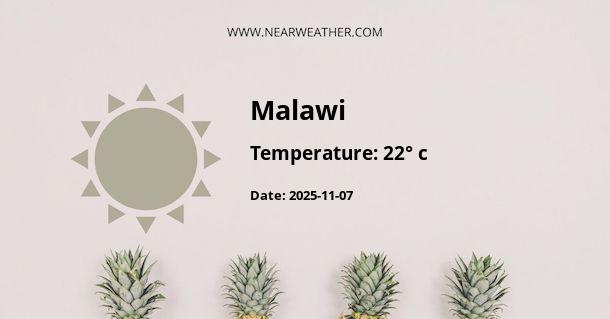The Climate and Weather of the Republic of Malawi
The Republic of Malawi, located in southeastern Africa, experiences a diverse climate and weather patterns throughout the year. From the highlands in the east to the lowlands in the west, the country's topography plays a significant role in shaping its climate. In this article, we will explore the different seasons and weather conditions that prevail in Malawi throughout the year.
1. Seasons in Malawi
Malawi has two distinct seasons: the dry season and the wet season. These seasons are primarily influenced by the Inter-Tropical Convergence Zone (ITCZ) and the movement of the African Easterly Jet, which plays a significant role in the formation of rainfall systems.
The dry season in Malawi usually occurs from May to October, while the wet season typically runs from November to April. Let's take a closer look at each of these seasons:
a. Dry Season (May to October)
The dry season in Malawi is characterized by low rainfall and cooler temperatures. During this period, the country experiences clear skies and sunny weather, making it an excellent time for outdoor activities and wildlife viewing.
The temperatures during the dry season vary across the country due to the varying altitude. In the highlands, temperatures can range from 10°C to 25°C (50°F to 77°F), while in the lowlands, temperatures can reach as high as 35°C (95°F). The nights in the highlands can be quite chilly, with temperatures dropping to around 5°C (41°F).
It is important to note that while the dry season is generally dry, some areas, particularly in the northern parts of Malawi, may still experience isolated showers or thunderstorms during this period.
b. Wet Season (November to April)
The wet season in Malawi is characterized by higher temperatures and significant rainfall. This is a vital period for agriculture in the country, as the rainfall supports the growth of crops. The wettest months are typically December to March.
During the wet season, Malawi experiences frequent rain showers, thunderstorms, and occasional heavy downpours. The rainfall distribution across the country varies, with the northern and central regions receiving more precipitation compared to the southern parts of Malawi.
Temperatures during the wet season range from 25°C to 35°C (77°F to 95°F) in the highlands and can exceed 35°C (95°F) in the lowlands. The humidity levels are also higher during this period, making it feel even hotter.
2. Regional Climate Variations
Due to its diverse topography, Malawi experiences regional climate variations. Let's explore the three main geographical regions of the country:
a. Northern Region
The northern region of Malawi is known for its highlands and plateau areas. This region receives the highest amount of rainfall in the country, particularly along the shores of Lake Malawi. The rainfall in the northern region supports the growth of lush vegetation and is responsible for the region's beautiful landscape.
The temperatures in the northern region are relatively cooler compared to the lowlands, with average highs ranging from 20°C to 28°C (68°F to 82°F) during the dry season. In the wet season, temperatures range from 25°C to 30°C (77°F to 86°F).
b. Central Region
The central region of Malawi consists of a mix of highlands, plateaus, and plains. This region experiences moderate rainfall compared to the north and south. The temperatures in the central region are similar to those in the northern region, with average highs ranging from 20°C to 28°C (68°F to 82°F) during the dry season and 25°C to 30°C (77°F to 86°F) during the wet season.
c. Southern Region
The southern region of Malawi is characterized by lower altitudes and plains. This region receives the least amount of rainfall compared to the rest of the country. The temperatures in the southern region are generally higher, with average highs ranging from 25°C to 35°C (77°F to 95°F) during the dry season and wet season.
3. Extreme Weather Events
Malawi is occasionally affected by extreme weather events, such as tropical storms and cyclones. These weather systems can result in heavy rainfall, strong winds, and flash floods. The southern region is particularly prone to these extreme weather events.
In recent years, Malawi has experienced severe flooding, which has caused significant damage to infrastructure, crops, and displaced communities. The government and international organizations have been working to improve disaster preparedness and response to mitigate the impact of these events.
Conclusion
The Republic of Malawi experiences a diverse climate and weather patterns throughout the year. From the dry season with its clear skies and cooler temperatures to the wet season with its frequent rain showers and higher temperatures, Malawi offers a range of experiences for both residents and visitors. The regional variations in climate add to the country's unique landscape and agricultural diversity. It is important to stay informed about the weather conditions and any potential extreme weather events when planning activities or traveling to Malawi.
A - Malawi's Latitude is -13.500000 & Longitude is 34.000000.
A - Weather in Malawi is 28° today.
A - Climate Conditions in Malawi shows clear sky today.
A - Humidity in Malawi is 40% today.
A - Wind speed in Malawi is 14.15 km/h, flowing at 76° wind direction. today.
